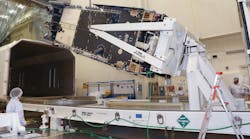Lockheed Martin has completed the majority of the assembly on its Hellas-Sat-4/SaudiGeoSat-1 communications satellite for Arabsat/Hellas Sat and King Abdulaziz City for Science and Technology. The satellite has been shipped to Lockheed Martin’s Sunnyvale, Calif. facility for environmental testing. When it is launched next year, this first of the modernized LM 2100 satellites will provide advanced telecommunications capabilities, including television, internet, telephone and secure military communications to customers in the Middle East, Africa, and Europe. The second of the two LM 2100 satellites in the Arabsat-6G program will be Arabsat-6A.
During environmental testing, the satellite will undergo tests to simulate launch and space conditions to ensure a successful mission. This testing includes simulating the launch environments with acoustic and vibration testing; simulating the harsh conditions of space by means of vacuum and extreme temperature testing; and conducting RF compatibility and performance testing to confirm that the communications payload performs as expected.
“Environmental testing is an essential set of activities to ensure the satellite can operate as designed in the extreme conditions of space and will meet our customers’ needs,” said Joe Rickers, Lockheed Martin’s Arabsat-6G program manager. “Now that assembly of the Hellas-Sat-4/SaudiGeoSat-1 satellite is complete and environmental testing is on the horizon, we’re one step closer to providing greatly improved communications capabilities for our customers.”
The satellite was designed, assembled, and integrated with its payload at the company’s Littleton, Colo. facility, where it recently went through comprehensive testing. Baseline testing remains to be performed before environmental testing will be conducted. The former ensures that the integrated satellite and its payload are working properly. While the satellite is in California, before it undergoes environmental testing, its large communications antennas and solar power arrays will be installed.
The satellite features four deployable antennas and multiple-mission modular flexible solar arrays that deliver 50% more power than previous rigid solar power arrays, with 30% less mass. The satellite is scheduled for delivery to the launch site in the third quarter of 2018.

